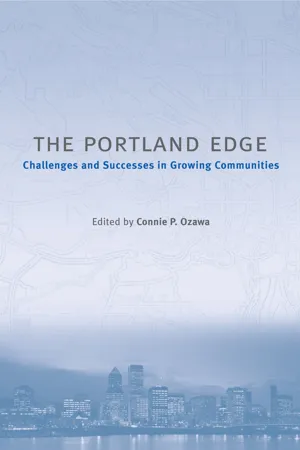
The Portland Edge
Challenges And Successes In Growing Communities
- English
- ePUB (mobile friendly)
- Available on iOS & Android
About This Book
Portland, Oregon, is often cited as one of the most livable cities in the United States and a model for "smart growth." At the same time, critics deride it as a victim of heavy-handed planning and point to its skyrocketing housing costs as a clear sign of good intentions gone awry. Which side is right? Does Portland deserve the accolades it has received, or has hype overshadowed the real story?
In The Portland Edge, leading urban scholars who have lived in and studied the region present a balanced look at Portland today, explaining current conditions in the context of the people and institutions that have been instrumental in shaping it. Contributors provide empirical data as well as critical insights and analyses, clarifying the ways in which policy and planning have made a difference in the Portland metropolitan region.
Because of its iconic status and innovative approach to growth, Portland is an important case study for anyone concerned with land use and community development in the twenty-first century. The Portland Edge offers useful background and a vital overview of region, allowing others to draw lessons from its experience.
Frequently asked questions
Information
1
The Portland Edge in Context
Portland is known as the “Capital of Good Planning” (Abbott 2000). For many urban planners the region has been the poster child for regional planning, growth management, and other innovative urban planning policies. While the following chapters examine a variety of issue areas in which the Portland region has gained this reputation, this chapter provides a broad context for that discussion. We begin by describing the region’s demographic and economic landscapes as well as the evolution of some key policies dealing with urban and regional planning. We provide some comparative statistics on metropolitan Portland and a number of similarly sized regions across the United States. We conclude by highlighting key challenges facing the region.
Things Look Different Here
Demographic Landscape


Economic Landscape
Table of contents
- ABOUT ISLAND PRESS
- Title Page
- Copyright Page
- Dedication
- Table of Contents
- List of Tables
- Table of Figures
- PREFACE
- Introduction - Challenges in Growing Communities
- 1 - The Portland Edge in Context
- 2 - It’s Not an Experiment: Regional Planning at Metro, 1990 to the Present
- 3 - Urban Redevelopment in Portland: Making the City Livable for Everyone?
- 4 - Dialectics of Control: The Origins and Evolution of Conflict in Portland’s Neighborhood Association Program
- 5 - The Myth and Reality of Portland’s Engaged Citizenry and Process-Oriented Governance
- 6 - Community Radio in Community Development: Portland’s KBOO Radio
- 7 - If Zealously Promoted by All: The Push and Pull of Portland Parks History
- 8 - Centers and Edges: Reshaping Downtown Portland
- 9 - The Reality of Portland’s Housing Market
- 10 - Housing Density and Livability in Portland
- 11 - The Evolution of Transportation Planning in the Portland Metropolitan Area
- 12 - Keeping the Green Edge: Stream Corridor Protection in the Portland Metropolitan Region
- 13 - Portland’s Reslvonse to Homeless Issues and the “Broken Windows” Theory
- Conclusion
- About the Contributors
- INDEX
- Island Press Board of Directors